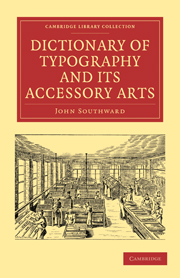Summary
HAIR SPACE.—The thinnest of the spaces. On an average ten hair spaces equal one cm, but occasionally they are made thicker, and sometimes thinner than this according to the body of the fount. There are seldom less than seven or more than ten hair spaces to the em.
HALF-CASE.—A case whose width is about half that of an ordinary upper case. The space between the uprights of a whole frame is usually equal to the breadth of one and a half cases. If a rack be fitted up within it there remains a space unoccupied, and this is sometimes filled by a board or galley rack, or left vacant, with only a shelf at the bottom. Half-cases are made in order to utilise this space, and by fixing up a small rack for them, about ten may be conveniently accommodated. They are exceedingly useful for holding titling letters or fancy founts. They contain forty-nine boxes.
HALF-FRAME.—A frame adapted to hold not more than one pair of cases without a rack.—See Frames.
HALF-MACHINE.—This is a term which has come into use since the small jobbing machines were invented. A person is said to work “half-machine” when he works the treadle, takes off and feeds at the same time.
HALF-PRESS.—When one man both rolls and pulls, he is said to work “half-press.”
HALF-SHEET.—When a forme is imposed in such a manner as to perfect itself, making two copies of a sheet, it is called a half-sheet.
- Type
- Chapter
- Information
- Dictionary of Typography and its Accessory Arts , pp. 45 - 49Publisher: Cambridge University PressPrint publication year: 2010First published in: 1875



